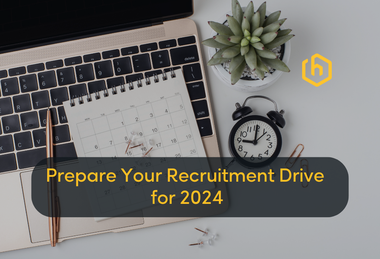1. Assess Your Needs
- Determine the number of positions you need to fill in 2024.
- Identify the skills, qualifications, and experience required for each position.
- Consider any new roles or departments that might be created.
To assess your hiring needs for the coming year, carefully evaluate your current workforce capabilities and identify specific skill gaps within your organisation. Additionally, analyse upcoming projects, business expansion plans, and industry trends to anticipate future demands, ensuring you align your hiring strategy with your company's growth objectives.
2. Update Job Descriptions
- Revise and update job descriptions to reflect the current requirements.
- Clearly outline roles, responsibilities, qualifications, and benefits.
- Highlight opportunities for career growth within the organisation.
When updating job descriptions before hiring, ensure clarity and specificity in outlining roles, responsibilities, and qualifications, providing a comprehensive overview of the position's expectations. Incorporate inclusive language and emphasise the company's values to attract diverse candidates, and regularly review and update job descriptions to align with evolving business needs and industry standards, ensuring accuracy and relevance in the recruitment process.
3. Employer Branding
- Enhance your company's online presence, including the website and social media profiles.
- Showcase your company culture, values, and employee testimonials.
- Engage current employees as brand ambassadors.
Employer branding is crucial when hiring as it shapes the perception of your company, attracting top talent who resonate with your values and culture. A strong employer brand enhances candidate attraction and fosters employee engagement, loyalty, and a positive work environment, contributing to your organisation's overall success and reputation.
4. Recruitment Strategy
- Decide on the recruitment methods:
-
- job boards
- social media
- employee referrals
- Consider partnering with recruitment agencies or universities for potential candidates.
- Plan for campus recruitment drives if applicable.
Utilise a mix of online platforms, networking events, and employee referrals to source candidates, and implement a streamlined, transparent hiring process that emphasises communication and candidate experience, ensuring you attract, assess, and retain the best talent for your organisation.
5. Application and Selection Process
- Set up an easy-to-navigate online application system on your company website.
- Develop a structured interview process, including technical and behavioural interviews.
- Consider using skills assessments or tests to evaluate candidates' abilities.
Designing a user-friendly online application system is essential in the application and selection process, ensuring it's mobile-responsive and easy to navigate. Implement a standardised, fair evaluation method involving diverse interview panels and structured questions to assess candidates objectively, allowing for a comprehensive understanding of their skills, experience, and cultural fit within the organisation.
6. Training for Interviewers
- Train your interviewers on fair and unbiased interviewing techniques.
- Ensure they are familiar with the skills and qualities the company seeks in candidates.
Before a hiring push, training interviewers is crucial. Provide them with comprehensive guidance on legal and ethical interviewing practices, conduct mock interviews to refine their skills, and emphasise the significance of evaluating qualifications and cultural fit to ensure a consistent and fair assessment process, ultimately leading to successful and unbiased candidate selections.
7. Diversity and Inclusion
- Promote diversity and inclusion in your workforce.
- Implement strategies to attract candidates from diverse backgrounds.
- Ensure a fair and unbiased selection process.
Diversity and inclusion are paramount in talent acquisition as they enhance creativity, foster innovation, and improve problem-solving within a diverse workforce. Embracing various perspectives and backgrounds reflects societal values. It strengthens the company culture, leading to higher employee engagement, improved decision-making, and a broader appeal to many customers and clients.
8. Employee Referral Programme
- Encourage current employees to refer suitable candidates.
- Offer incentives or rewards for successful referrals.
An employee referral programme is vital for your hiring plan because it leverages the existing workforce's network, enabling you to tap into a pool of qualified candidates trusted by your employees, resulting in higher-quality hires and enhanced retention rates.
9. Onboarding Process
- Review and update your onboarding process to ensure a smooth transition for new hires.
- Assign mentors or buddies to help new employees acclimate to the company culture.
Best practices for your onboarding process include providing clear job expectations, offering comprehensive training, assigning a mentor or buddy for support, fostering a welcoming environment, and ensuring new employees integrate smoothly into the company culture and become productive contributors from day one.
10. Compliance and Documentation
- Ensure all recruitment processes comply with local labour laws and regulations.
- Maintain detailed records of the recruitment process, including applications, interviews, and offers.
Compliance is critical when creating a staffing plan to ensure adherence to legal regulations, mitigate risks, and maintain ethical practices, safeguarding the organisation from potential legal liabilities and reputational damage.
11. Follow-up and Feedback
- Gather feedback from candidates about their recruitment experience.
- Analyse the effectiveness of your recruitment strategies and make necessary adjustments.
Providing follow-up and feedback to all candidates during the hiring process is crucial for fostering a positive candidate experience, enhancing the employer brand, and maintaining open communication, which reflects the organisation's professionalism and respect for applicants' time and effort.
12. Budget and Resources
- Allocate a budget for recruitment advertising, events, and other related expenses.
- Allocate human resources for conducting interviews, reviewing applications, and other recruitment activities.
Planning your budget is a critical part of your talent acquisition process because it allows for the strategic allocation of resources, ensuring efficient recruitment efforts, comprehensive training programs, and competitive compensation packages, ultimately attracting and retaining top talent while maintaining financial stability for the organisation.
13. Continuous Improvement
- Regularly assess the effectiveness of your recruitment processes.
- Stay updated with the latest trends and technologies in recruitment.
Focusing on continuous improvement throughout the year when developing a hiring strategy is essential as it allows businesses to adapt to evolving market demands, stay ahead of industry trends, and refine recruitment processes based on real-time feedback, ensuring a dynamic and practical approach to talent acquisition that aligns with the organisation's changing needs and goals.
Increasing Hiring Success Through Technology
By following this comprehensive plan, you can effectively prepare for your recruitment drive in 2024, ensuring that you attract the best candidates to join your organisation.
You don't have to go it alone. Investing in the right software gives you the structure and framework to manage talent and what you have to offer. Using a system to help you track and hire top talent is the first step in the process.
With more competition for top talent, it pays for companies to consider all their advantages and the use of tools to assist in the quest to find talent. HireHive helps busy people hire great people. You can post jobs, streamline your online application process, improve the candidate experience, and tap into vast global networks by having your entire recruitment process in one place.
Set up a free demo today. Contact HireHive to learn more.







